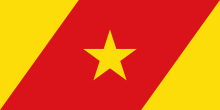Basona Werana
Debre Berhan Zuria or Basona Werana ("Baso and Werana") is one of the woredas in the Amhara Region of Ethiopia. Located at the eastern edge of the Ethiopian highlands in the Semien Shewa Zone, Basona Werana is bordered on the south by Angolalla Tera, on the southwest by the Oromia Region, on the west by Siyadebrina Wayu, on the northwest by Moretna Jiru, on the north by Mojana Wadera, on the northeast by Termaber, and on the east by Ankober. The town and woreda of Debre Berhan is an enclave inside this woreda. Towns in this woreda include Gudoberet.
Debre Berhan Zuria ደብረ ብርሃን ዙሪያ | |
|---|---|
Woreda | |
 Flag | |
| Zone | Semien Shewa |
| Region | Amhara Region |
| Area | |
| • Total | 1,208.17 km2 (466.48 sq mi) |
| Population (2012 est.) | |
| • Total | 130,403 |
This woreda was originally named Debre Berhan Zuria ("Greater Debre Berhan"), the name used in the 1994 national census, but it was changed before the Ethiopian Agricultural Sample Survey in October 2001, which used the present name.
The Battle of Segale was fought on 27 October 1916 in this woreda. In this battle, the supporters of Emperor Iyasu V of Ethiopia were defeated, which secured the outcome of the palace coup the previous month, in which Zawditu had been proclaimed Empress.
Demographics
Based on the 2007 national census conducted by the Central Statistical Agency of Ethiopia (CSA), this woreda has a total population of 120,930, an increase of 7.81% over the 1994 census, of whom 61,924 are men and 59,006 women; 1,219 or 1.01% are urban inhabitants. With an area of 1,208.17 square kilometers, Basona Werana has a population density of 100.09, which is less than the Zone average of 115.3 persons per square kilometer. A total of 27,753 households were counted in this woreda, resulting in an average of 4.36 persons to a household, and 26,918 housing units. The majority of the inhabitants practiced Ethiopian Orthodox Christianity, with 99.93% reporting that as their religion.[2]
The 1994 national census reported a total population for this woreda of 112,173 in 24,307 households, of whom 56,868 were men and 55,305 were women; the census reported no urban dwellers. The largest ethnic group reported in Basona Werana was the Amhara (99.46%), and Amharic was spoken as a first language by 99.33%. The majority of the inhabitants practiced Ethiopian Orthodox Christianity, with 99.96% reporting that as their religion.[3]
Notes
- Geohive: Ethiopia Archived 2012-08-05 at the Wayback Machine
- Census 2007 Tables: Amhara Region Archived November 14, 2010, at the Wayback Machine, Tables 2.1, 2.4, 2.5, 3.1, 3.2 and 3.4.
- 1994 Population and Housing Census of Ethiopia: Results for Amhara Region, Vol. 1, part 1 Archived November 15, 2010, at the Wayback Machine, Tables 2.1, 2.7, 2.10, 2.13, 2.17, Annex II.2 (accessed 9 April 2009)